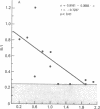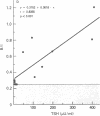Abstract
We have developed a new bioassay for thyrotropin (TSH) in human serum to evaluate bioactivity in normal individuals and patients with different degrees of primary hypothyroidism. Unpurified TSH in serum showed no stimulation of cyclic AMP production in cultured FRTL-5 rat thyroid cells, but after immunopurification showed potent stimulatory activity. Immunoaffinity purification permitted up to 400-fold concentration of serum TSH, allowing bioactivity measurements even in certain normal sera. The limit of detection in the FRTL-5 bioassay was 10 microU of human TSH per 0.5 ml incubate, and half-maximal responses for standard human TSH was 102 +/- 26 (+/- SE) microU/0.5 ml. Immunoaffinity-purified serum TSH varied in bioactivity-to-immunoactivity (B/I) ratios from less than 0.25 to 1.21 among four euthyroid subjects and eight primary hypothyroid patients. An inverse correlation was found between B/I ratios of immunopurified basal TSH and the serum-free T4 (r = -0.7237, P less than 0.01), T4 (r = -0.6650, P less than 0.05), and T3 (r = -0.6382, P less than 0.05). B/I ratios of immunopurified TSH from three hypothyroid patients before and after acute stimulation by thyrotropin-releasing hormone showed no significant change, despite major changes in serum TSH. In summary, the present study shows an inverse relationship between the metabolic status of an individual and the intrinsic bioactivity of TSH.
Full text
PDF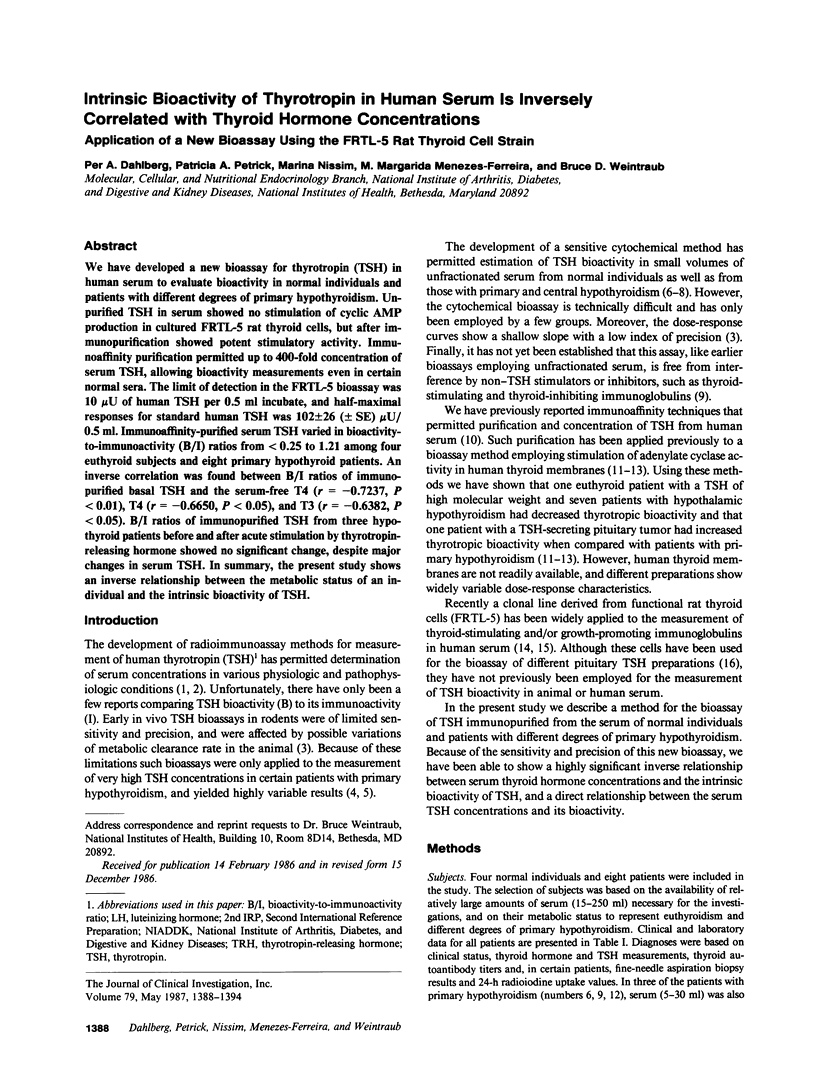
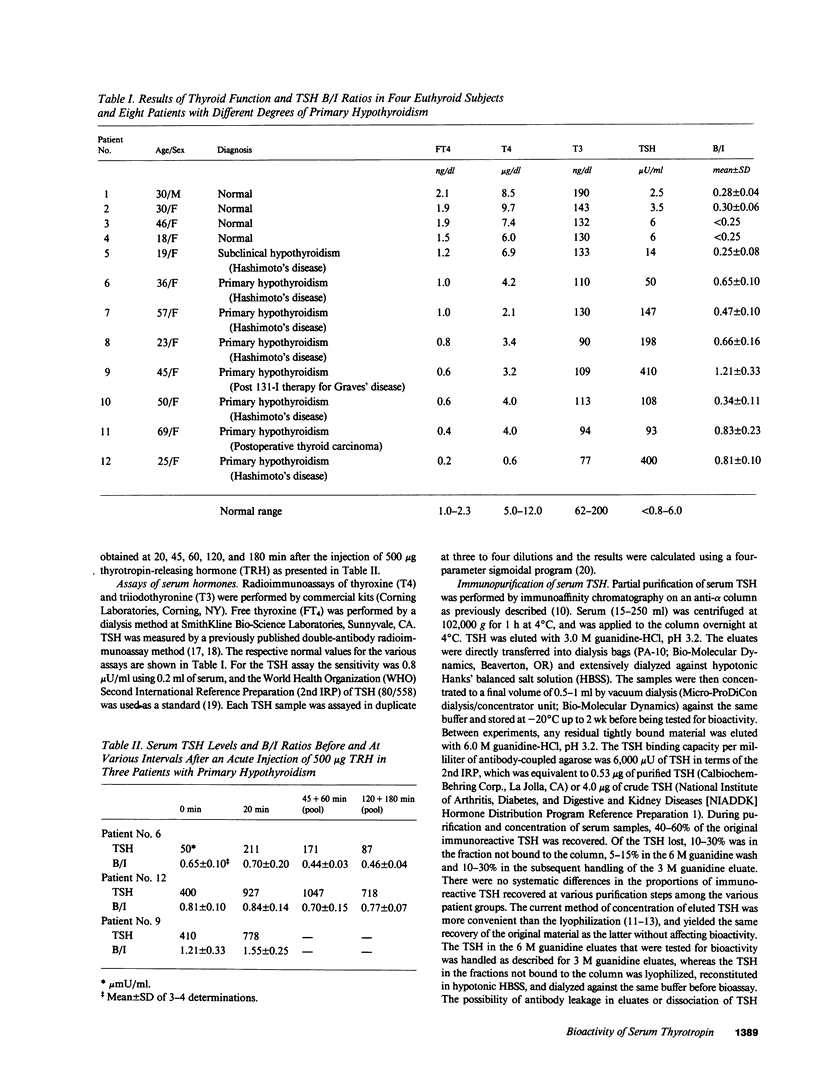

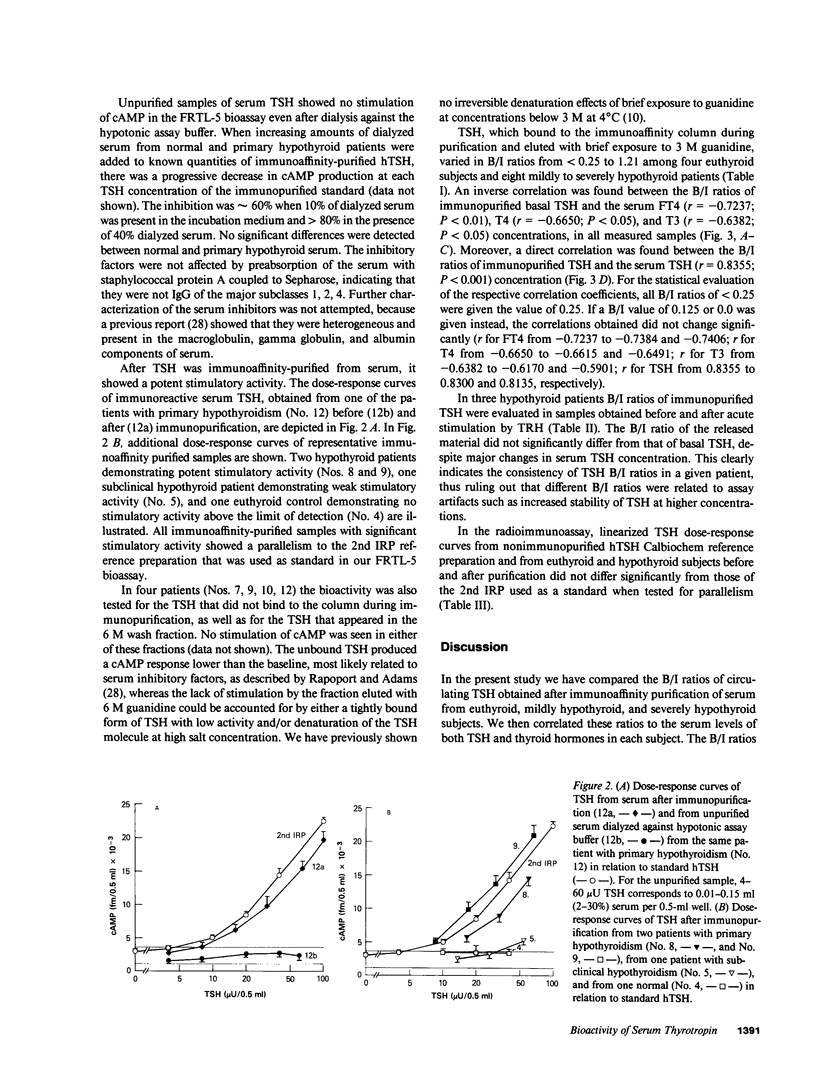
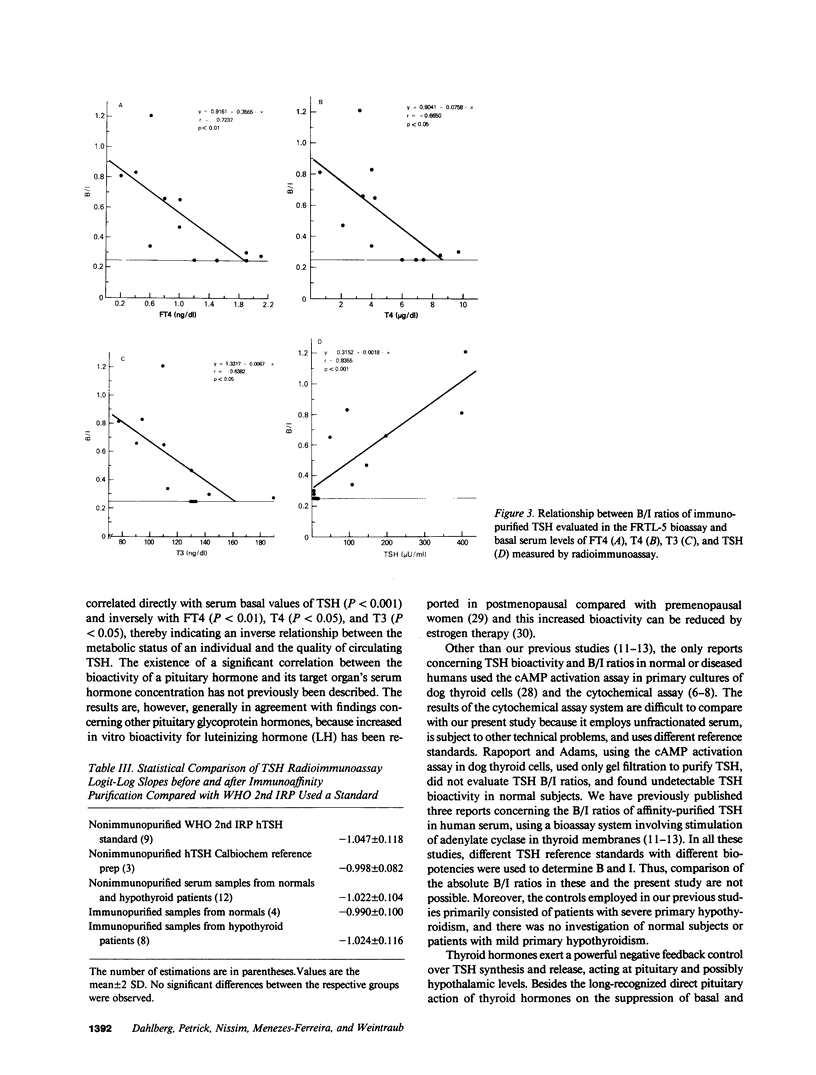


Images in this article
Selected References
These references are in PubMed. This may not be the complete list of references from this article.
- Ambesi-Impiombato F. S., Parks L. A., Coon H. G. Culture of hormone-dependent functional epithelial cells from rat thyroids. Proc Natl Acad Sci U S A. 1980 Jun;77(6):3455–3459. doi: 10.1073/pnas.77.6.3455. [DOI] [PMC free article] [PubMed] [Google Scholar]
- Amr S., Menezez-Ferreira M., Shimohigashi Y., Chen H. C., Nisula B., Weintraub B. D. Activities of deglycosylated thyrotropin at the thyroid membrane receptor-adenylate cyclase system. J Endocrinol Invest. 1985 Dec;8(6):537–541. doi: 10.1007/BF03348556. [DOI] [PubMed] [Google Scholar]
- Beck-Peccoz P., Amr S., Menezes-Ferreira M. M., Faglia G., Weintraub B. D. Decreased receptor binding of biologically inactive thyrotropin in central hypothyroidism. Effect of treatment with thyrotropin-releasing hormone. N Engl J Med. 1985 Apr 25;312(17):1085–1090. doi: 10.1056/NEJM198504253121703. [DOI] [PubMed] [Google Scholar]
- Beck-Peccoz P., Piscitelli G., Amr S., Ballabio M., Bassetti M., Giannattasio G., Spada A., Nissim M., Weintraub B. D., Faglia G. Endocrine, biochemical, and morphological studies of a pituitary adenoma secreting growth hormone, thyrotropin (TSH), and alpha-subunit: evidence for secretion of TSH with increased bioactivity. J Clin Endocrinol Metab. 1986 Apr;62(4):704–711. doi: 10.1210/jcem-62-4-704. [DOI] [PubMed] [Google Scholar]
- Belchetz P. E., Gredley G., Bird D., Himsworth R. L. Regulation of thyrotrophin secretion by negative feedback of tri-iodothyronine on the hypothalamus. J Endocrinol. 1978 Mar;76(3):439–448. doi: 10.1677/joe.0.0760439. [DOI] [PubMed] [Google Scholar]
- Bidey S. P., Ryder K., Gaines-Das R., Marshall N. J., Ekins R. P. A comparison of the bioactivity of human and bovine thyrotrophin preparations, as determined by intracellular cyclic AMP responses of cultured FRTL-5 cells and human thyroid cell monolayers. Acta Endocrinol (Copenh) 1984 Aug;106(4):482–489. doi: 10.1530/acta.0.1060482. [DOI] [PubMed] [Google Scholar]
- Burstein S., Schaff-Blass E., Blass J., Rosenfield R. L. The changing ratio of bioactive to immunoreactive luteinizing hormone (LH) through puberty principally reflects changing LH radioimmunoassay dose-response characteristics. J Clin Endocrinol Metab. 1985 Sep;61(3):508–513. doi: 10.1210/jcem-61-3-508. [DOI] [PubMed] [Google Scholar]
- Constant R. B., Weintraub B. D. Differences in the metabolic clearance of pituitary and serum thyrotropin (TSH) derived from euthyroid and hypothyroid rats: effects of chemical deglycosylation of pituitary TSH. Endocrinology. 1986 Dec;119(6):2720–2727. doi: 10.1210/endo-119-6-2720. [DOI] [PubMed] [Google Scholar]
- DeLean A., Munson P. J., Rodbard D. Simultaneous analysis of families of sigmoidal curves: application to bioassay, radioligand assay, and physiological dose-response curves. Am J Physiol. 1978 Aug;235(2):E97–102. doi: 10.1152/ajpendo.1978.235.2.E97. [DOI] [PubMed] [Google Scholar]
- Dufau M. L., Beitins I. Z., McArthur J. W., Catt K. J. Effects of luteinizing hormone releasing hormone (LHRH) upon bioactive and immunoreactive serum LH levels in normal subjects. J Clin Endocrinol Metab. 1976 Sep;43(3):658–667. doi: 10.1210/jcem-43-3-658. [DOI] [PubMed] [Google Scholar]
- Faglia G., Bitensky L., Pinchera A., Ferrari C., Paracchi A., Beck-Peccoz P., Ambrosi B., Spada A. Thyrotropin secretion in patients with central hypothyroidism: evidence for reduced biological activity of immunoreactive thyrotropin. J Clin Endocrinol Metab. 1979 Jun;48(6):989–998. doi: 10.1210/jcem-48-6-989. [DOI] [PubMed] [Google Scholar]
- Gaines Das R. E., Bristow A. F. The Second International Reference Preparation of Thyroid-Stimulating Hormone, Human, for Immunoassay: calibration by bioassay and immunoassay in an international collaborative study. J Endocrinol. 1985 Mar;104(3):367–379. doi: 10.1677/joe.0.1040367. [DOI] [PubMed] [Google Scholar]
- Gershengorn M. C., Weintraub B. D. Thyrotropin-induced hyperthyroidism caused by selective pituitary resistance to thyroid hormone. A new syndrome of "inappropriate secretion of TSH". J Clin Invest. 1975 Sep;56(3):633–642. doi: 10.1172/JCI108133. [DOI] [PMC free article] [PubMed] [Google Scholar]
- Gurr J. A., Kourides I. A. Thyroid hormone regulation of thyrotropin alpha- and beta-subunit gene transcription. DNA. 1985 Aug;4(4):301–307. doi: 10.1089/dna.1985.4.301. [DOI] [PubMed] [Google Scholar]
- Harper J. F., Brooker G. Femtomole sensitive radioimmunoassay for cyclic AMP and cyclic GMP after 2'0 acetylation by acetic anhydride in aqueous solution. J Cyclic Nucleotide Res. 1975;1(4):207–218. [PubMed] [Google Scholar]
- Hershman J. M., Pittman J. A., Jr Utility of the radioimmunoassay of serum thyrotrophin in man. Ann Intern Med. 1971 Apr;74(4):481–490. doi: 10.7326/0003-4819-74-4-481. [DOI] [PubMed] [Google Scholar]
- Joshi L. R., Weintraub B. D. Naturally occurring forms of thyrotropin with low bioactivity and altered carbohydrate content act as competitive antagonists to more bioactive forms. Endocrinology. 1983 Dec;113(6):2145–2154. doi: 10.1210/endo-113-6-2145. [DOI] [PubMed] [Google Scholar]
- Kasagi K., Konishi J., Iida Y., Ikekubo K., Mori T., Kuma K., Torizuka K. A new in vitro assay for human thyroid stimulator using cultured thyroid cells: effect of sodium chloride on adenosine 3',5'-monophosphate increase. J Clin Endocrinol Metab. 1982 Jan;54(1):108–114. doi: 10.1210/jcem-54-1-108. [DOI] [PubMed] [Google Scholar]
- Larsen P. R. Thyroid-pituitary interaction: feedback regulation of thyrotropin secretion by thyroid hormones. N Engl J Med. 1982 Jan 7;306(1):23–32. doi: 10.1056/NEJM198201073060107. [DOI] [PubMed] [Google Scholar]
- Lucky A. W., Rebar R. W., Rosenfield R. L., Roche-Bender N., Helke J. Reduction of the potency of luteinizing hormone by estrogen. N Engl J Med. 1979 May 3;300(18):1034–1036. doi: 10.1056/NEJM197905033001808. [DOI] [PubMed] [Google Scholar]
- Menezes-Ferreira M. M., Petrick P. A., Weintraub B. D. Regulation of thyrotropin (TSH) bioactivity by TSH-releasing hormone and thyroid hormone. Endocrinology. 1986 May;118(5):2125–2130. doi: 10.1210/endo-118-5-2125. [DOI] [PubMed] [Google Scholar]
- Miyai K., Fukuchi M., Kumahara Y. Correlation between biological and immunological potencies of human serum and pituitary thyrotropin. J Clin Endocrinol Metab. 1969 Nov;29(11):1438–1442. doi: 10.1210/jcem-29-11-1438. [DOI] [PubMed] [Google Scholar]
- Pekonen F., Williams D. M., Weintraub B. D. Purification of thyrotropin and other glycoprotein hormones by immunoaffinity chromatography. Endocrinology. 1980 May;106(5):1327–1332. doi: 10.1210/endo-106-5-1327. [DOI] [PubMed] [Google Scholar]
- Petersen V., Hall R., Smith B. F. A study of thyroid stimulating activity in human serum with the highly sensitive cytochemical bioassay. J Clin Endocrinol Metab. 1975 Jul;41(1):199–202. doi: 10.1210/jcem-41-1-199. [DOI] [PubMed] [Google Scholar]
- Rapoport B., Adams R. J. Bioassay of TSH using dog thyroid cells in monolayer culture. Metabolism. 1978 Dec;27(12):1732–1742. doi: 10.1016/0026-0495(78)90259-7. [DOI] [PubMed] [Google Scholar]
- Rapoport B., Greenspan F. S., Filetti S., Pepitone M. Clinical experience with a human thyroid cell bioassay for thyroid-stimulating immunoglobulin. J Clin Endocrinol Metab. 1984 Feb;58(2):332–338. doi: 10.1210/jcem-58-2-332. [DOI] [PubMed] [Google Scholar]
- Ridgway E. C., Weintraub B. D., Cevallos J. L., Rack M. C., Maloof F. Suppression of pituitary TSH secretion in the patient with a hyperfunctioning thyroid nodule. J Clin Invest. 1973 Nov;52(11):2783–2792. doi: 10.1172/JCI107474. [DOI] [PMC free article] [PubMed] [Google Scholar]
- Ronin C., Stannard B. S., Weintraub B. D. Differential processing and regulation of thyroid-stimulating hormone subunit carbohydrate chains in thyrotropic tumors and in normal and hypothyroid pituitaries. Biochemistry. 1985 Sep 24;24(20):5626–5631. doi: 10.1021/bi00341a051. [DOI] [PubMed] [Google Scholar]
- Shupnik M. A., Chin W. W., Habener J. F., Ridgway E. C. Transcriptional regulation of the thyrotropin subunit genes by thyroid hormone. J Biol Chem. 1985 Mar 10;260(5):2900–2903. [PubMed] [Google Scholar]
- Spitz I. M., Le Roith D., Hirsch H., Carayon P., Pekonen F., Liel Y., Sobel R., Chorer Z., Weintraub B. Increased high-molecular-weight thyrotropin with impaired biologic activity in a euthyroid man. N Engl J Med. 1981 Jan 29;304(5):278–282. doi: 10.1056/NEJM198101293040506. [DOI] [PubMed] [Google Scholar]
- Steiner A. L., Kipnis D. M., Utiger R., Parker C. Radioimmunoassay for the measurement of adenosine 3',5'-cyclic phosphate. Proc Natl Acad Sci U S A. 1969 Sep;64(1):367–373. doi: 10.1073/pnas.64.1.367. [DOI] [PMC free article] [PubMed] [Google Scholar]
- Taylor T., Weintraub B. D. Differential regulation of thyrotropin subunit apoprotein and carbohydrate biosynthesis by thyroid hormone. Endocrinology. 1985 Apr;116(4):1535–1542. doi: 10.1210/endo-116-4-1535. [DOI] [PubMed] [Google Scholar]
- Taylor T., Weintraub B. D. Thyrotropin (TSH)-releasing hormone regulation of TSH subunit biosynthesis and glycosylation in normal and hypothyroid rat pituitaries. Endocrinology. 1985 May;116(5):1968–1976. doi: 10.1210/endo-116-5-1968. [DOI] [PubMed] [Google Scholar]
- Valente W. A., Vitti P., Kohn L. D., Brandi M. L., Rotella C. M., Toccafondi R., Tramontano D., Aloj S. M., Ambesi-Impiombato F. S. The relationship of growth and adenylate cyclase activity in cultured thyroid cells: separate bioeffects of thyrotropin. Endocrinology. 1983 Jan;112(1):71–79. doi: 10.1210/endo-112-1-71. [DOI] [PubMed] [Google Scholar]
- Valente W. A., Vitti P., Rotella C. M., Vaughan M. M., Aloj S. M., Grollman E. F., Ambesi-Impiombato F. S., Kohn L. D. Antibodies that promote thyroid growth. A distinct population of thyroid-stimulating autoantibodies. N Engl J Med. 1983 Oct 27;309(17):1028–1034. doi: 10.1056/NEJM198310273091705. [DOI] [PubMed] [Google Scholar]
- Valente W. A., Yavin Z., Yavin E., Grollman E. F., Schneider M., Rotella C. M., Zonefrati R., Toccafondi R. S., Kohn L. D. Monoclonal antibodies to the thyrotropin receptor: the identification of blocking and stimulating antibodies. J Endocrinol Invest. 1982 Sep-Oct;5(5):293–301. doi: 10.1007/BF03350517. [DOI] [PubMed] [Google Scholar]
- Vitti P., Valente W. A., Ambesi-Impiombato F. S., Fenzi G. F., Pinchera A., Kohn L. D. Graves' IgG stimulation of continuously cultured rat thyroid cells: a sensitive and potentially useful clinical assay. J Endocrinol Invest. 1982 May-Jun;5(3):179–182. doi: 10.1007/BF03349476. [DOI] [PubMed] [Google Scholar]
- Wehmann R. E., Nisula B. C. Radioimmunoassay of human thyrotropin: analytical and clinical developments. Crit Rev Clin Lab Sci. 1984;20(3):243–283. doi: 10.3109/10408368409165776. [DOI] [PubMed] [Google Scholar]
- Wide L., Wide M. Higher plasma disappearance rate in the mouse for pituitary follicle-stimulating hormone of young women compared to that of men and elderly women. J Clin Endocrinol Metab. 1984 Mar;58(3):426–429. doi: 10.1210/jcem-58-3-426. [DOI] [PubMed] [Google Scholar]






